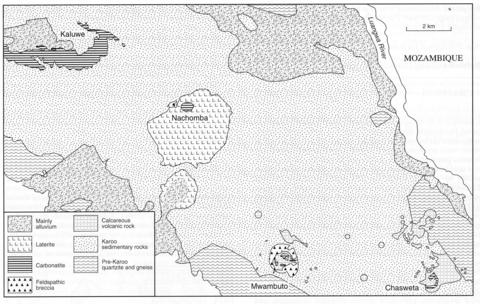stripes
Chasweta is an eroded volcano with two principal vents indicated by shallow depressions. There are numerous satellite vents around the complex and the remnants of the products of these vents are widespread to the north. Intrusive carbonatite forms a partial ring around the eastern side of the main vent and cuts an earlier group of pyroclastic rocks, but is itself transected by later pyroclastics. The most abundant rock at Chasweta is an agglomerate distributed around the main vents and consisting of sub-rounded fragments averaging 5-8 cm across comprising earlier carbonatitic tuff or agglomerate with rarer fragments of country rocks. The matrix consists of finer agglomerate and tuff particles in a fine-grained base of dolomitic or ankeritic carbonate. A younger bedded agglomerate around the main vent cuts the intrusive carbonatite and contains abundant angular fragments of carbonatite and feldspathic breccia. Extrusive tuffs usually have some bedding and generally consist of ferruginous carbonate that forms the matrix of the coarser volcanics. Microscopically the pyroclastic rocks are widely variable and consist of carbonatite fragments, carbonate grains, plentiful orthoclase and accessory barite, phlogopite, quartz grains and opaque phases. The intrusive carbonatites are concentrically banded with vertical or steep dips but differ from the pyroclastic rocks in being essentially calcitic. Several large areas and lenses of brecciated feldspar rock and argillite lie in the carbonatite near the margins and smaller fragments, including pre-Karoo rocks, are widespread. Silicification and jaspillite veining is abundant and veins of calcite, calcite-barite and calcite-pyrolusite are also present. The carbonatite contains disseminated iron and manganese oxides, barite, pyrochlore, monazite, phlogopite, and orthoclase as accessories. Bailey (1989) has described chrome-rich spinels (up to 52 wt % Cr2O5) in tuffisites from Chasweta that he takes to indicate a direct mantle origin for the carbonatite pyroclastic rocks. Whole rock data, including major and trace elements and Rb, Sr, Sm and Nd isotopes, for three ferrocarbonatites and a sovite are given by Ziegler (1992), and further information on tuffisite chemistry is in Bailey (1990).
BAILEY, D.K. 1960. Carbonatites of the Rufunsa Valley, Feira District. Bulletin, Geological Survey of Northern Rhodesia, 5: 1-92.BAILEY, D.K. 1966. Carbonatite volcanoes and shallow intrusions in Zambia. In O.F. Tuttle and J.Gittins (eds) Carbonatites. 127-54. John Wiley, New York.BAILEY, D.K. 1989. Carbonate melt from the mantle in the volcanoes of south-east Zambia. Nature, London, 338: 415-8.BAILEY, D.K. 1990. Mantle carbonatite eruptions: crustal context and implications. Lithos, 26: 37-42.ZIEGLER, U.R.F. 1992. Preliminary results of geochemistry, Sm-Nd and Rb-Sr studies of post-Karoo carbonatite complexes in southern Africa. Schweizerische Mineralogische und Petrographische Mitteilungen. Zurich, 72: 141-8.

